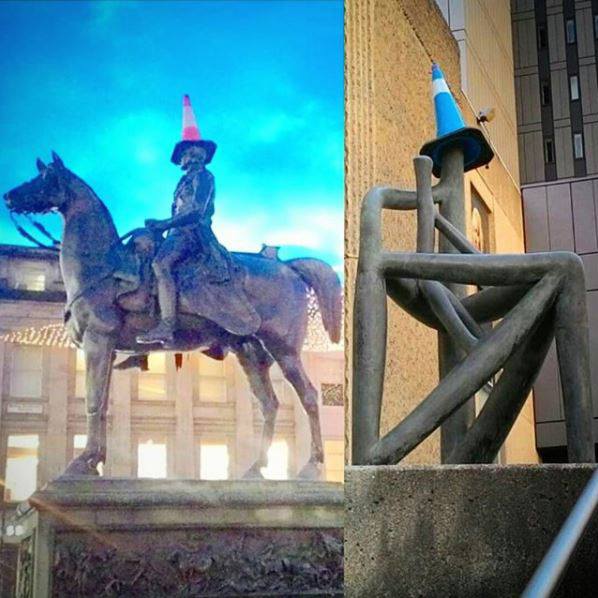ONE of Britain’s top universities has asked Glasgwegians to explain their fondness for sticking traffic cones on top of statues.
The University of Glasgow, part of the elite Russell group, suggests the rest of the world is baffled by the custom, which usually targets the Duke of Wellington in Royal Exchange Square.
The institution put its request on social media after a blue cone was stuck on an abstract statue outside its library – Diagram of an Object.

They wrote: “Are there any Glaswegians willing to take a crack at explaining ‘the cone’ to our international audience?
“Any ideas on how it appeared on a sculpture outside of our library are welcome too.”
Among those to respond was Johnny White who wrote: “It’s part of Glasgow’s radical past. Making fun of po-faced Imperial statues as a way of pointing out that all people are equal and no one is above anyone else. A laugh at pomposity.”
Graham McClure wrote: “Capping the statue with a traffic cone is a traditional practice in the city, claimed to represent the humour of the local population.”
Frank Gallagher offered: “It’s an expression of working class resistance via the symbolic prohibition contained in the cone subverted by placing it on the authoritarian figure of repression that is the reactionary Duke of Wellington.”
Others sought a less high-brow explanation, including Diane Lambert who wrote: “And here I just thought it was someone who thought it was a good idea after a wee night out in the toon!”
And Denis Dolan observed: “Drunk people kept putting it on everytime it was taken down. The city council have accepted that it’s not worth the hassle any more to take it down.”
While Michael Kvamme-O’Brien had his own theory – that Glasgow Council staff sneak off and place the cone on the Duke himself.
He wrote: “The council do it to try and make the place look interesting”
Hannah Lois said: “It needs no explaining. Don’t overthink it, just enjoy the smile it brings to your day.”
And Pam Gibson wrote: “It’s started in the 80s probably a prank, at first but it’s now as much a fixture as Wellington himself.”
A University of Glasgow spokeswoman today (thur) said: “We saw that the picture of the statue was doing well on social media so we decided to share it with our UofG community and ask if anyone could explain why the cone is there – mainly to our international students.
“The Duke of Wellington statue and the cone is iconic in the city and we thought our audiences would enjoy the picture and engage with the post.”
The A-listed equestrian statue was erected in 1844 and is deemed one of Glasgow’s most iconic sights.
In the past, Glasgow City Council and Police Scotland have tried to discourage people from climbing on the statue to cap the duke for risk of damages to the landmark and injuries to the people involved.
The statue has featured an array of different cones in the past including a rainbow one in honour of gay pride.
In the past it has been reported to cost the council £10,000 -per-year for them to remove the traffic cones.
In 2013, Glasgow City Council proposed plans to double the height of its plinth as part of a £65,000 restoration project.
The plans were withdrawn after widespread public opposition mirrored by a Facebook campaign called “Keep the Cone” which accumulated more than 72,000 likes in just one day.
In 2015, Glasgow City Council successfully tested out hi-tech CCTV software worth £1.2m by checking to see whether it could automatically detect people putting cones on the statue.
The capping has also inspired other members of the public to put traffic cones on the top of statues across Scotland in the past.